child lock SKODA FABIA 2014 3.G / NJ Operating Instruction Manual
[x] Cancel search | Manufacturer: SKODA, Model Year: 2014, Model line: FABIA, Model: SKODA FABIA 2014 3.G / NJPages: 216, PDF Size: 30.9 MB
Page 73 of 216
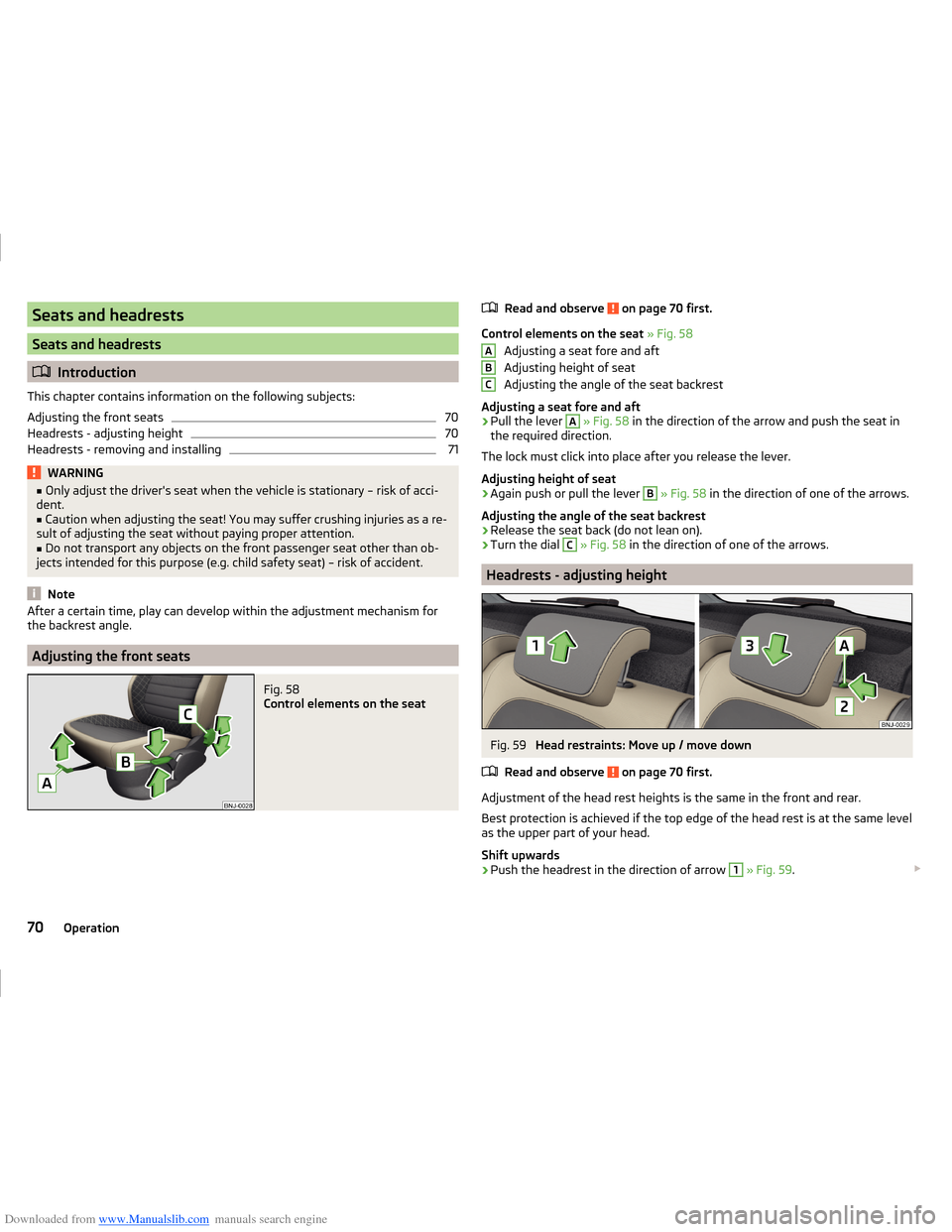
Downloaded from www.Manualslib.com manuals search engine Seats and headrests
Seats and headrests
Introduction
This chapter contains information on the following subjects:
Adjusting the front seats
70
Headrests - adjusting height
70
Headrests - removing and installing
71WARNING■ Only adjust the driver's seat when the vehicle is stationary – risk of acci-
dent.■
Caution when adjusting the seat! You may suffer crushing injuries as a re-
sult of adjusting the seat without paying proper attention.
■
Do not transport any objects on the front passenger seat other than ob-
jects intended for this purpose (e.g. child safety seat) – risk of accident.
Note
After a certain time, play can develop within the adjustment mechanism for
the backrest angle.
Adjusting the front seats
Fig. 58
Control elements on the seat
Read and observe on page 70 first.
Control elements on the seat » Fig. 58
Adjusting a seat fore and aft
Adjusting height of seat
Adjusting the angle of the seat backrest
Adjusting a seat fore and aft
›
Pull the lever
A
» Fig. 58 in the direction of the arrow and push the seat in
the required direction.
The lock must click into place after you release the lever.
Adjusting height of seat
›
Again push or pull the lever
B
» Fig. 58 in the direction of one of the arrows.
Adjusting the angle of the seat backrest
›
Release the seat back (do not lean on).
›
Turn the dial
C
» Fig. 58 in the direction of one of the arrows.
Headrests - adjusting height
Fig. 59
Head restraints: Move up / move down
Read and observe
on page 70 first.
Adjustment of the head rest heights is the same in the front and rear.
Best protection is achieved if the top edge of the head rest is at the same level as the upper part of your head.
Shift upwards
›
Push the headrest in the direction of arrow
1
» Fig. 59 .
ABC70Operation
Page 75 of 216
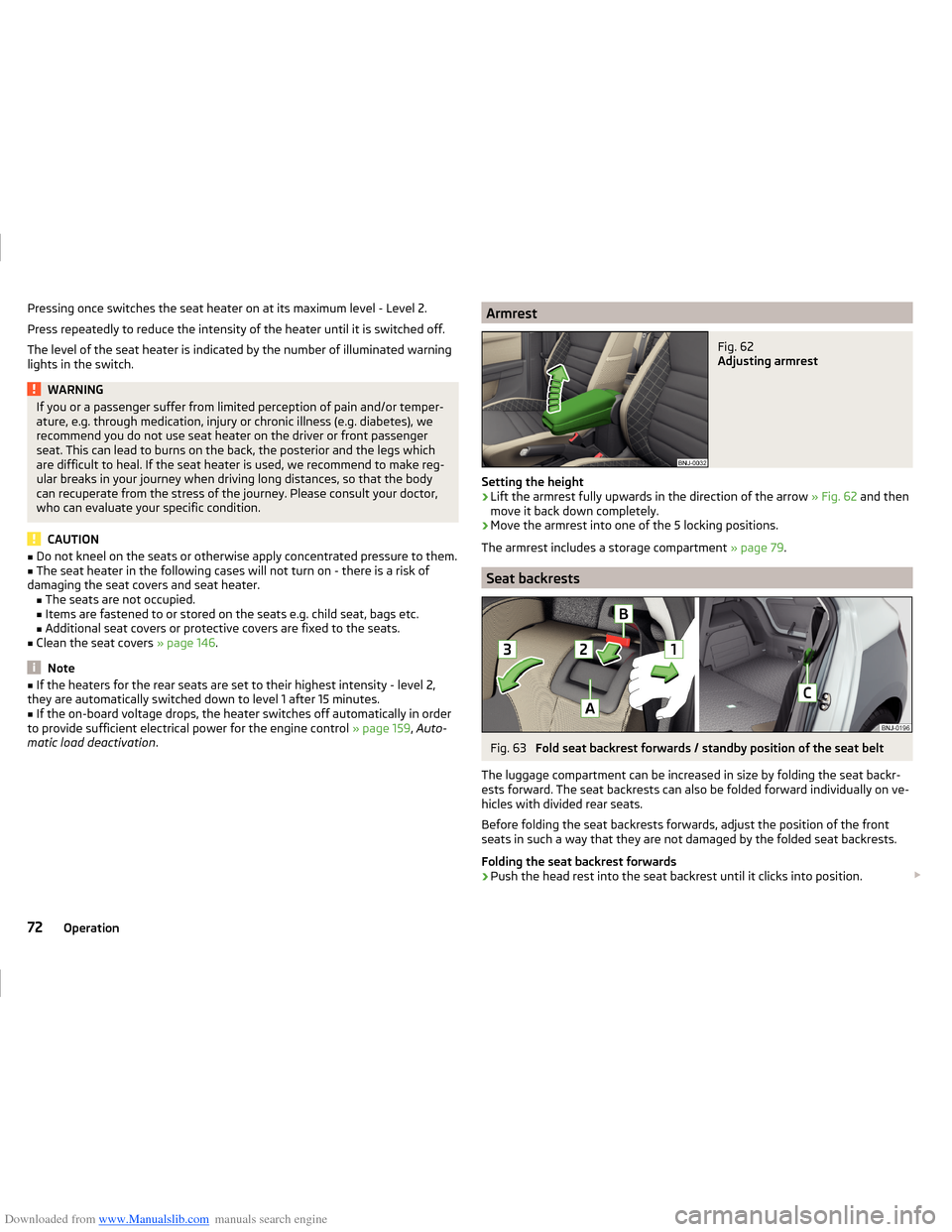
Downloaded from www.Manualslib.com manuals search engine Pressing once switches the seat heater on at its maximum level - Level 2.
Press repeatedly to reduce the intensity of the heater until it is switched off.
The level of the seat heater is indicated by the number of illuminated warning
lights in the switch.WARNINGIf you or a passenger suffer from limited perception of pain and/or temper-
ature, e.g. through medication, injury or chronic illness (e.g. diabetes), we
recommend you do not use seat heater on the driver or front passenger
seat. This can lead to burns on the back, the posterior and the legs which
are difficult to heal. If the seat heater is used, we recommend to make reg-
ular breaks in your journey when driving long distances, so that the body
can recuperate from the stress of the journey. Please consult your doctor,
who can evaluate your specific condition.
CAUTION
■ Do not kneel on the seats or otherwise apply concentrated pressure to them.■The seat heater in the following cases will not turn on - there is a risk of
damaging the seat covers and seat heater. ■The seats are not occupied.
■ Items are fastened to or stored on the seats e.g. child seat, bags etc.
■ Additional seat covers or protective covers are fixed to the seats.■
Clean the seat covers » page 146.
Note
■
If the heaters for the rear seats are set to their highest intensity - level 2,
they are automatically switched down to level 1 after 15 minutes.■
If the on-board voltage drops, the heater switches off automatically in order
to provide sufficient electrical power for the engine control » page 159, Auto-
matic load deactivation .
ArmrestFig. 62
Adjusting armrest
Setting the height
›
Lift the armrest fully upwards in the direction of the arrow » Fig. 62 and then
move it back down completely.
›
Move the armrest into one of the 5 locking positions.
The armrest includes a storage compartment » page 79.
Seat backrests
Fig. 63
Fold seat backrest forwards / standby position of the seat belt
The luggage compartment can be increased in size by folding the seat backr-
ests forward. The seat backrests can also be folded forward individually on ve-
hicles with divided rear seats.
Before folding the seat backrests forwards, adjust the position of the front
seats in such a way that they are not damaged by the folded seat backrests.
Folding the seat backrest forwards
›
Push the head rest into the seat backrest until it clicks into position.
72Operation
Page 103 of 216
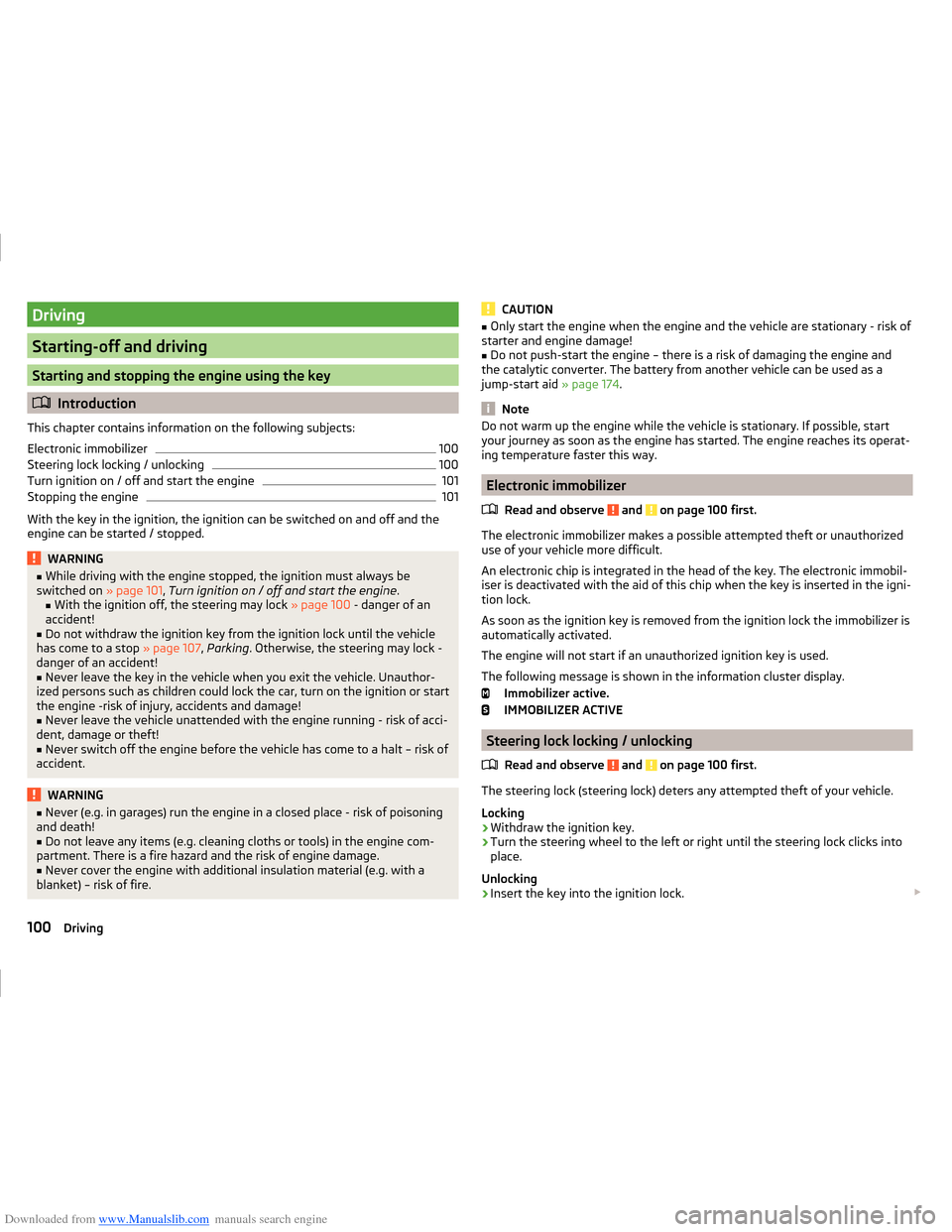
Downloaded from www.Manualslib.com manuals search engine Driving
Starting-off and driving
Starting and stopping the engine using the key
Introduction
This chapter contains information on the following subjects:
Electronic immobilizer
100
Steering lock locking / unlocking
100
Turn ignition on / off and start the engine
101
Stopping the engine
101
With the key in the ignition, the ignition can be switched on and off and the
engine can be started / stopped.
WARNING■ While driving with the engine stopped, the ignition must always be
switched on » page 101, Turn ignition on / off and start the engine .
■ With the ignition off, the steering may lock » page 100 - danger of an
accident!■
Do not withdraw the ignition key from the ignition lock until the vehicle
has come to a stop » page 107, Parking . Otherwise, the steering may lock -
danger of an accident!
■
Never leave the key in the vehicle when you exit the vehicle. Unauthor-
ized persons such as children could lock the car, turn on the ignition or start
the engine -risk of injury, accidents and damage!
■
Never leave the vehicle unattended with the engine running - risk of acci-
dent, damage or theft!
■
Never switch off the engine before the vehicle has come to a halt – risk of
accident.
WARNING■ Never (e.g. in garages) run the engine in a closed place - risk of poisoning
and death!■
Do not leave any items (e.g. cleaning cloths or tools) in the engine com-
partment. There is a fire hazard and the risk of engine damage.
■
Never cover the engine with additional insulation material (e.g. with a
blanket) – risk of fire.
CAUTION■ Only start the engine when the engine and the vehicle are stationary - risk of
starter and engine damage!■
Do not push-start the engine – there is a risk of damaging the engine and
the catalytic converter. The battery from another vehicle can be used as a
jump-start aid » page 174.
Note
Do not warm up the engine while the vehicle is stationary. If possible, start
your journey as soon as the engine has started. The engine reaches its operat-
ing temperature faster this way.
Electronic immobilizer
Read and observe
and on page 100 first.
The electronic immobilizer makes a possible attempted theft or unauthorizeduse of your vehicle more difficult.
An electronic chip is integrated in the head of the key. The electronic immobil-
iser is deactivated with the aid of this chip when the key is inserted in the igni-
tion lock.
As soon as the ignition key is removed from the ignition lock the immobilizer is
automatically activated.
The engine will not start if an unauthorized ignition key is used.
The following message is shown in the information cluster display. Immobilizer active.
IMMOBILIZER ACTIVE
Steering lock locking / unlocking
Read and observe
and on page 100 first.
The steering lock (steering lock) deters any attempted theft of your vehicle.
Locking
›
Withdraw the ignition key.
›
Turn the steering wheel to the left or right until the steering lock clicks into
place.
Unlocking
›
Insert the key into the ignition lock.
100Driving
Page 105 of 216
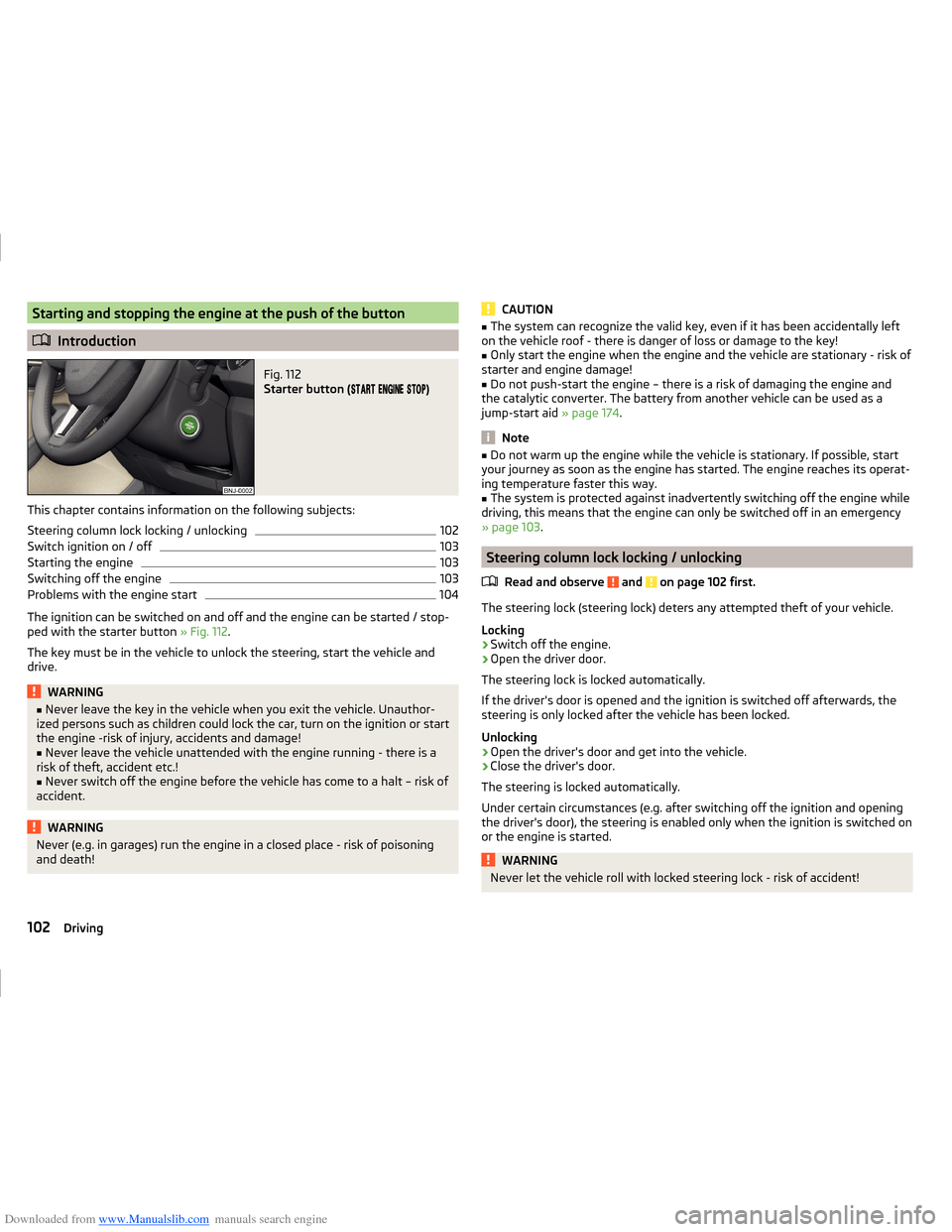
Downloaded from www.Manualslib.com manuals search engine Starting and stopping the engine at the push of the button
Introduction
Fig. 112
Starter button (
)
This chapter contains information on the following subjects:
Steering column lock locking / unlocking
102
Switch ignition on / off
103
Starting the engine
103
Switching off the engine
103
Problems with the engine start
104
The ignition can be switched on and off and the engine can be started / stop-
ped with the starter button » Fig. 112.
The key must be in the vehicle to unlock the steering, start the vehicle and
drive.
WARNING■ Never leave the key in the vehicle when you exit the vehicle. Unauthor-
ized persons such as children could lock the car, turn on the ignition or start
the engine -risk of injury, accidents and damage!■
Never leave the vehicle unattended with the engine running - there is a
risk of theft, accident etc.!
■
Never switch off the engine before the vehicle has come to a halt – risk of
accident.
WARNINGNever (e.g. in garages) run the engine in a closed place - risk of poisoning
and death!CAUTION■ The system can recognize the valid key, even if it has been accidentally left
on the vehicle roof - there is danger of loss or damage to the key!■
Only start the engine when the engine and the vehicle are stationary - risk of
starter and engine damage!
■
Do not push-start the engine – there is a risk of damaging the engine and
the catalytic converter. The battery from another vehicle can be used as a
jump-start aid » page 174.
Note
■
Do not warm up the engine while the vehicle is stationary. If possible, start
your journey as soon as the engine has started. The engine reaches its operat-
ing temperature faster this way.■
The system is protected against inadvertently switching off the engine while
driving, this means that the engine can only be switched off in an emergency
» page 103 .
Steering column lock locking / unlocking
Read and observe
and on page 102 first.
The steering lock (steering lock) deters any attempted theft of your vehicle.
Locking
›
Switch off the engine.
›
Open the driver door.
The steering lock is locked automatically.
If the driver's door is opened and the ignition is switched off afterwards, the
steering is only locked after the vehicle has been locked.
Unlocking
›
Open the driver's door and get into the vehicle.
›
Close the driver's door.
The steering is locked automatically.
Under certain circumstances (e.g. after switching off the ignition and opening
the driver's door), the steering is enabled only when the ignition is switched on
or the engine is started.
WARNINGNever let the vehicle roll with locked steering lock - risk of accident!102Driving
Page 204 of 216
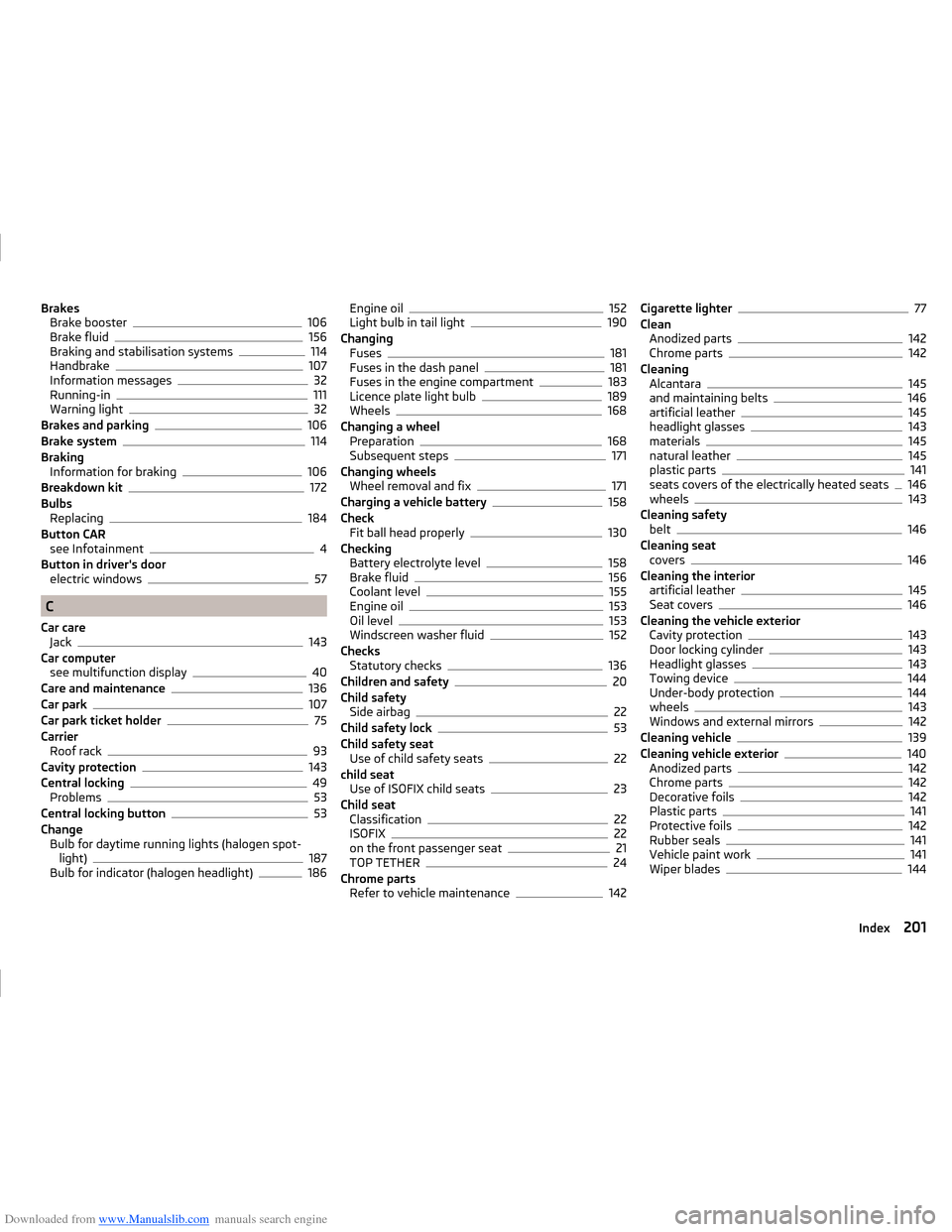
Downloaded from www.Manualslib.com manuals search engine BrakesBrake booster106
Brake fluid156
Braking and stabilisation systems114
Handbrake107
Information messages32
Running-in111
Warning light32
Brakes and parking106
Brake system114
Braking Information for braking
106
Breakdown kit172
Bulbs Replacing
184
Button CAR see Infotainment
4
Button in driver's door electric windows
57
C
Car care Jack
143
Car computer see multifunction display
40
Care and maintenance136
Car park107
Car park ticket holder75
Carrier Roof rack
93
Cavity protection143
Central locking49
Problems53
Central locking button53
Change Bulb for daytime running lights (halogen spot- light)
187
Bulb for indicator (halogen headlight)186
Engine oil152
Light bulb in tail light190
Changing Fuses
181
Fuses in the dash panel181
Fuses in the engine compartment183
Licence plate light bulb189
Wheels168
Changing a wheel Preparation
168
Subsequent steps171
Changing wheels Wheel removal and fix
171
Charging a vehicle battery158
Check Fit ball head properly
130
Checking Battery electrolyte level
158
Brake fluid156
Coolant level155
Engine oil153
Oil level153
Windscreen washer fluid152
Checks Statutory checks
136
Children and safety20
Child safety Side airbag
22
Child safety lock53
Child safety seat Use of child safety seats
22
child seat Use of ISOFIX child seats
23
Child seat Classification
22
ISOFIX22
on the front passenger seat21
TOP TETHER24
Chrome parts Refer to vehicle maintenance
142
Cigarette lighter77
Clean Anodized parts
142
Chrome parts142
Cleaning Alcantara
145
and maintaining belts146
artificial leather145
headlight glasses143
materials145
natural leather145
plastic parts141
seats covers of the electrically heated seats146
wheels143
Cleaning safety belt
146
Cleaning seat covers
146
Cleaning the interior artificial leather
145
Seat covers146
Cleaning the vehicle exterior Cavity protection
143
Door locking cylinder143
Headlight glasses143
Towing device144
Under-body protection144
wheels143
Windows and external mirrors142
Cleaning vehicle139
Cleaning vehicle exterior140
Anodized parts142
Chrome parts142
Decorative foils142
Plastic parts141
Protective foils142
Rubber seals141
Vehicle paint work141
Wiper blades144
201Index
Page 205 of 216
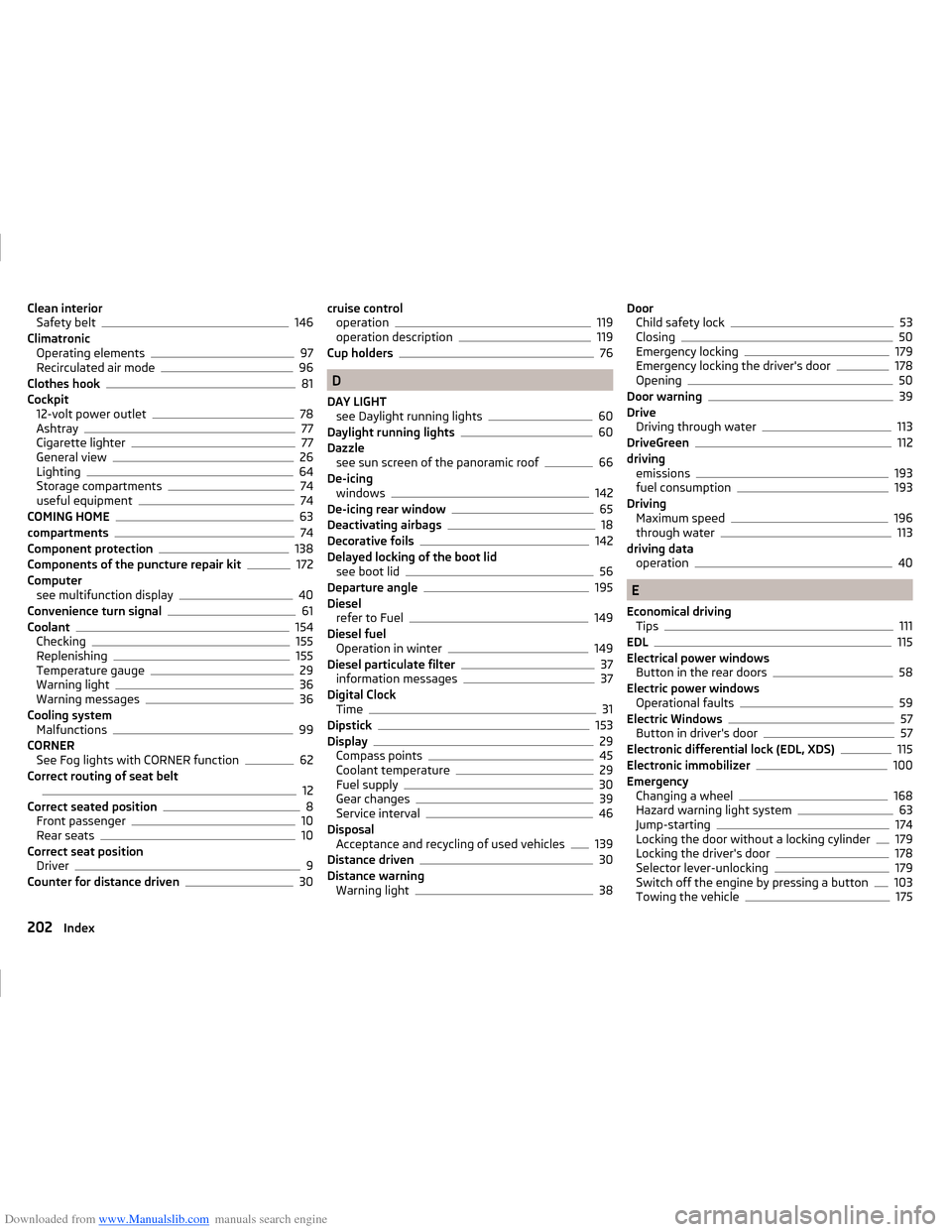
Downloaded from www.Manualslib.com manuals search engine Clean interiorSafety belt146
Climatronic Operating elements
97
Recirculated air mode96
Clothes hook81
Cockpit 12-volt power outlet
78
Ashtray77
Cigarette lighter77
General view26
Lighting64
Storage compartments74
useful equipment74
COMING HOME63
compartments74
Component protection138
Components of the puncture repair kit172
Computer see multifunction display
40
Convenience turn signal61
Coolant154
Checking155
Replenishing155
Temperature gauge29
Warning light36
Warning messages36
Cooling system Malfunctions
99
CORNER See Fog lights with CORNER function
62
Correct routing of seat belt
12
Correct seated position8
Front passenger10
Rear seats10
Correct seat position Driver
9
Counter for distance driven30
cruise control operation119
operation description119
Cup holders76
D
DAY LIGHT see Daylight running lights
60
Daylight running lights60
Dazzle see sun screen of the panoramic roof
66
De-icing windows
142
De-icing rear window65
Deactivating airbags18
Decorative foils142
Delayed locking of the boot lid see boot lid
56
Departure angle195
Diesel refer to Fuel
149
Diesel fuel Operation in winter
149
Diesel particulate filter37
information messages37
Digital Clock Time
31
Dipstick153
Display29
Compass points45
Coolant temperature29
Fuel supply30
Gear changes39
Service interval46
Disposal Acceptance and recycling of used vehicles
139
Distance driven30
Distance warning Warning light
38
DoorChild safety lock53
Closing50
Emergency locking179
Emergency locking the driver's door178
Opening50
Door warning39
Drive Driving through water
113
DriveGreen112
driving emissions
193
fuel consumption193
Driving Maximum speed
196
through water113
driving data operation
40
E
Economical driving Tips
111
EDL115
Electrical power windows Button in the rear doors
58
Electric power windows Operational faults
59
Electric Windows57
Button in driver's door57
Electronic differential lock (EDL, XDS)115
Electronic immobilizer100
Emergency Changing a wheel
168
Hazard warning light system63
Jump-starting174
Locking the door without a locking cylinder179
Locking the driver's door178
Selector lever-unlocking179
Switch off the engine by pressing a button103
Towing the vehicle175
202Index
Page 209 of 216
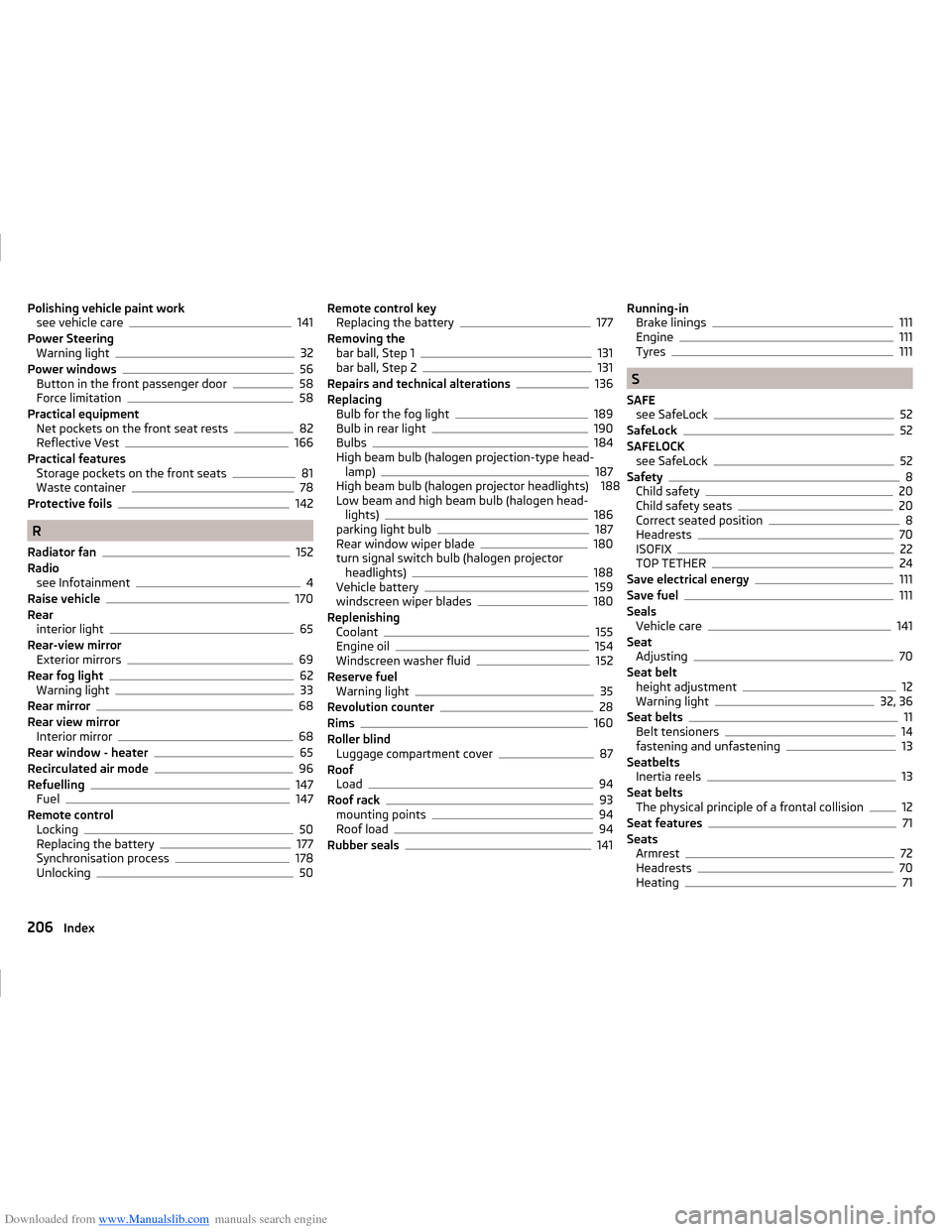
Downloaded from www.Manualslib.com manuals search engine Polishing vehicle paint worksee vehicle care141
Power Steering Warning light
32
Power windows56
Button in the front passenger door58
Force limitation58
Practical equipment Net pockets on the front seat rests
82
Reflective Vest166
Practical features Storage pockets on the front seats
81
Waste container78
Protective foils142
R
Radiator fan
152
Radio see Infotainment
4
Raise vehicle170
Rear interior light
65
Rear-view mirror Exterior mirrors
69
Rear fog light62
Warning light33
Rear mirror68
Rear view mirror Interior mirror
68
Rear window - heater65
Recirculated air mode96
Refuelling147
Fuel147
Remote control Locking
50
Replacing the battery177
Synchronisation process178
Unlocking50
Remote control key Replacing the battery177
Removing the bar ball, Step 1
131
bar ball, Step 2131
Repairs and technical alterations136
Replacing Bulb for the fog light
189
Bulb in rear light190
Bulbs184
High beam bulb (halogen projection-type head- lamp)
187
High beam bulb (halogen projector headlights) 188 Low beam and high beam bulb (halogen head- lights)
186
parking light bulb187
Rear window wiper blade180
turn signal switch bulb (halogen projector headlights)
188
Vehicle battery159
windscreen wiper blades180
Replenishing Coolant
155
Engine oil154
Windscreen washer fluid152
Reserve fuel Warning light
35
Revolution counter28
Rims160
Roller blind Luggage compartment cover
87
Roof Load
94
Roof rack93
mounting points94
Roof load94
Rubber seals141
Running-in Brake linings111
Engine111
Tyres111
S
SAFE see SafeLock
52
SafeLock52
SAFELOCK see SafeLock
52
Safety8
Child safety20
Child safety seats20
Correct seated position8
Headrests70
ISOFIX22
TOP TETHER24
Save electrical energy111
Save fuel111
Seals Vehicle care
141
Seat Adjusting
70
Seat belt height adjustment
12
Warning light32, 36
Seat belts11
Belt tensioners14
fastening and unfastening13
Seatbelts Inertia reels
13
Seat belts The physical principle of a frontal collision
12
Seat features71
Seats Armrest
72
Headrests70
Heating71
206Index
Page 211 of 216
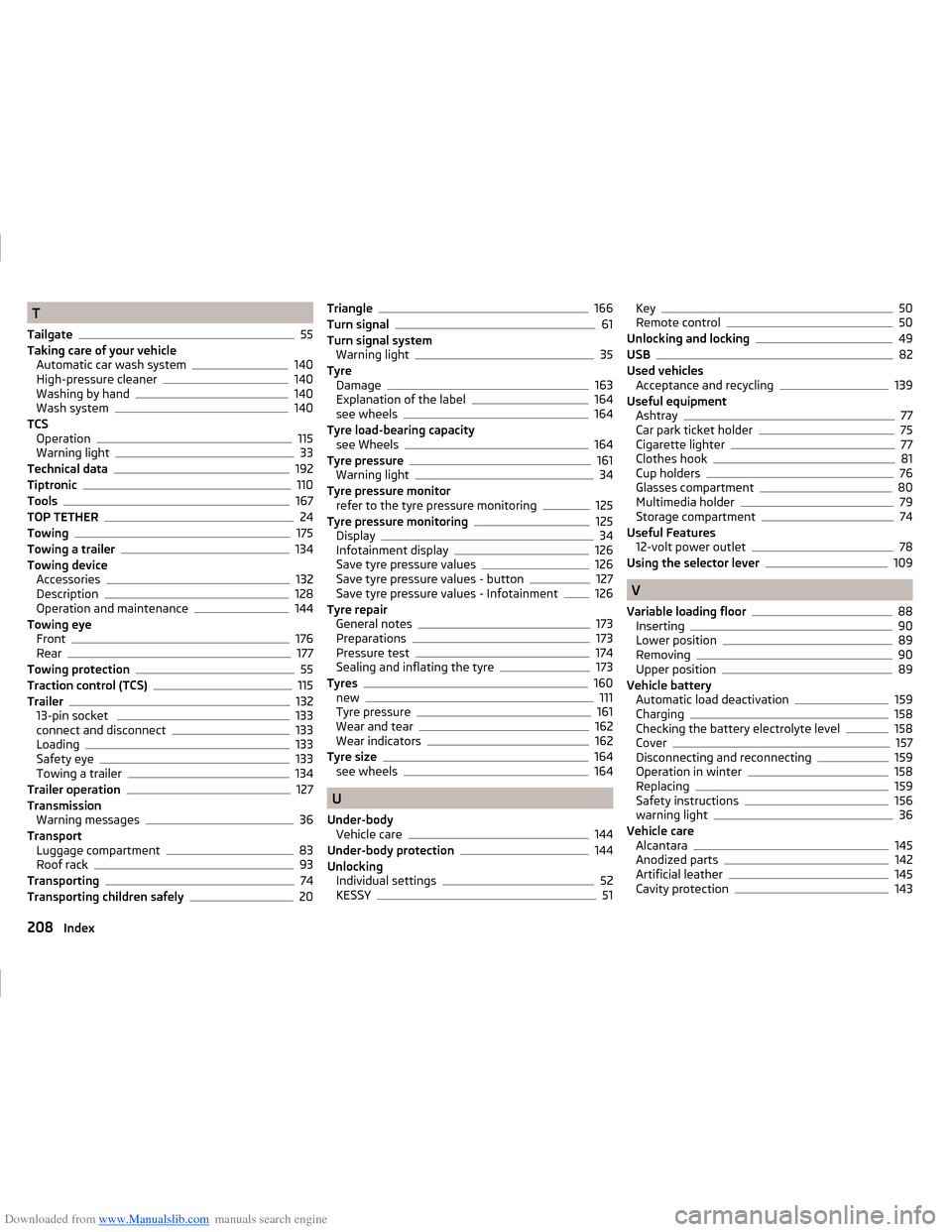
Downloaded from www.Manualslib.com manuals search engine T
Tailgate
55
Taking care of your vehicle Automatic car wash system
140
High-pressure cleaner140
Washing by hand140
Wash system140
TCS Operation
115
Warning light33
Technical data192
Tiptronic110
Tools167
TOP TETHER24
Towing175
Towing a trailer134
Towing device Accessories
132
Description128
Operation and maintenance144
Towing eye Front
176
Rear177
Towing protection55
Traction control (TCS)115
Trailer132
13-pin socket 133
connect and disconnect133
Loading133
Safety eye133
Towing a trailer134
Trailer operation127
Transmission Warning messages
36
Transport Luggage compartment
83
Roof rack93
Transporting74
Transporting children safely20
Triangle166
Turn signal61
Turn signal system Warning light
35
Tyre Damage
163
Explanation of the label164
see wheels164
Tyre load-bearing capacity see Wheels
164
Tyre pressure161
Warning light34
Tyre pressure monitor refer to the tyre pressure monitoring
125
Tyre pressure monitoring125
Display34
Infotainment display126
Save tyre pressure values126
Save tyre pressure values - button127
Save tyre pressure values - Infotainment126
Tyre repair General notes
173
Preparations173
Pressure test174
Sealing and inflating the tyre173
Tyres160
new111
Tyre pressure161
Wear and tear162
Wear indicators162
Tyre size164
see wheels164
U
Under-body Vehicle care
144
Under-body protection144
Unlocking Individual settings
52
KESSY51
Key50
Remote control50
Unlocking and locking49
USB82
Used vehicles Acceptance and recycling
139
Useful equipment Ashtray
77
Car park ticket holder75
Cigarette lighter77
Clothes hook81
Cup holders76
Glasses compartment80
Multimedia holder79
Storage compartment74
Useful Features 12-volt power outlet
78
Using the selector lever109
V
Variable loading floor
88
Inserting90
Lower position89
Removing90
Upper position89
Vehicle battery Automatic load deactivation
159
Charging158
Checking the battery electrolyte level158
Cover157
Disconnecting and reconnecting159
Operation in winter158
Replacing159
Safety instructions156
warning light36
Vehicle care Alcantara
145
Anodized parts142
Artificial leather145
Cavity protection143
208Index